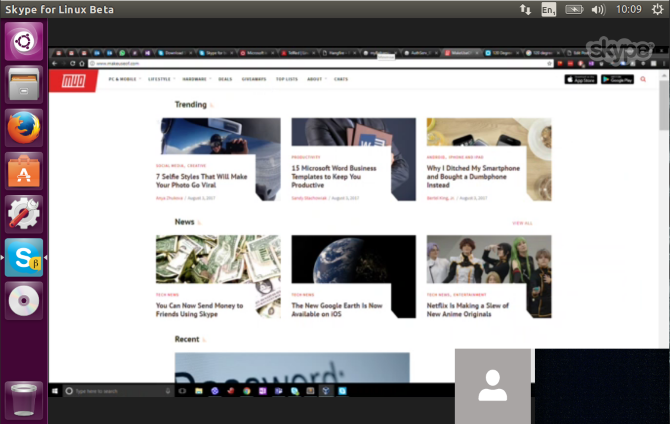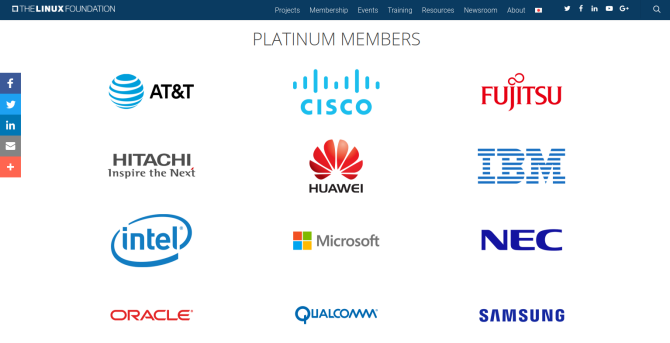Several years ago, Microsoft CEO Satya Nadella stood in front of a presentation slide that said Microsoft loves Linux. Some people were happy to see this change. Others were skeptical. Did Microsoft really love Linux after all?
Microsoft is a corporate entity, so it isn’t big on emotions. But over the past few years, the company has embraced Linux in quite a few big ways.
1. Microsoft Released Its Own Linux Distribution
Azure Sphere is an operating system for ARM-based hardware. Specifically, Microsoft is targeting internet of Things devices, like smart thermostats and fitness trackers.
The part that has attracted attention? Rather than creating a Windows-based alternative, Microsoft’s Azure Sphere is based on Linux. Not only that, the product is mostly open source. It will offer what it calls royalty-free licensing to partners such as MediaTek, Qualcomm, and Toshiba.
Why?
Microsoft is competing with the likes of Amazon, which also produces Linux-based offerings. Microsoft has decided it can make more money selling Azure cloud services than trying to sell a proprietary product with an upfront cost. The company also wants to attract developers and engineers that have grown accustomed to open source technologies.
2. Microsoft Ships Linux Distros in the Windows Store
In 2017, Linux distributions became available inside the Microsoft Store. People using Windows gained the ability to download copies of Ubuntu, Fedora, and openSUSE that they could run without having to wipe their computers or use a virtual machine.
These Linux-based operating systems (or “distributions”) run via the Windows Subsystem for Linux. Technically, you don’t get the full Linux experience. The store instead provides system tools inside of the Linux shell. But with the right tinkering, you can load a complete Linux desktop inside of Windows.
Why?
Many developers and web designers view Linux and macOS as having better tools for creating software and websites. Microsoft doesn’t want to continue losing these potential customers. Also, some people that love Windows still have to regularly interact with machines that run a different operating system, such as servers. This is a way for Microsoft to address both issues.
3. Microsoft Now Designs Software for Linux

Skype is the big one. The Linux version went neglected for years, but Microsoft did bring the app up to speed last year.
You can also download Visual Studio Code, an integrated desktop environment. And while there isn’t a native Linux version of Microsoft Office, you can use Office 365 in a browser.
Sure, the list isn’t long, but you might be surprised to see any items on this list at all, given the former relationship.
Why?
While Microsoft is still widely associated with its Windows desktop operating system, the company’s wealth now comes from services such as Office and Azure. CEO Nadella has stated that one fifth of the operating systems on Azure are Linux. It’s now in Microsoft’s financial interest to support competing operating systems. Doing otherwise limits how far its products can reach.
4. Microsoft Contributes to the Linux Kernel
In the open source world, code is free for all to use, edit, and share. Much of this software is provided as-is, and there’s no help desk obligated to fix any issues. This is true even of the Linux kernel, the essential background component from which the operating system derives its name.
If you find a bug, or if you want a feature added, the best course of action is to program those changes yourself. And that’s just what Microsoft has done over the years.
Why?
Microsoft contributions generally come in the form of drivers intended to make Linux integrate more smoothly with the company’s technologies.
In 2011, Microsoft became a top 5 contributor to Linux version 3.0 with the amount of code it introduced to make distributions play along nicely with its Hyper-V hypervisor-based virtualization system (an alternative to the Linux’s own kernel-based virtualization manager).
Microsoft’s driver consists of tens of thousands of lines of code, so while it would become number 17 among contributors in 2012, its contributions were almost entirely contained in this area.
5. Microsoft Is a Member of the Linux Foundation

In 2016, Microsoft joined the Linux Foundation at the platinum level, making it one of the highest spending members. For comparison, Google, whose Android and Chrome OS operating systems are based on Linux, is a silver member. As is Red Hat, the world’s most profitable open source company.
Why?
Like other software developers, Microsoft utilizes a number of open source projects. Investing in the Linux Foundation is one way to channel support back to these offerings that the company doesn’t have to pay for.
There’s also a decent amount of prestige that comes with having your name at the top. What kind of people are most likely to know who is a member of the Linux Foundation? Software developers, the kind of potential employees Microsoft needs to attract to stay competitive.
6. Microsoft Developers Make Linux-Related Videos
Channel 9 provides “videos for developers from the people building Microsoft products and services.” Topics range from coding and artificial intelligence to managing servers and building communities, with well over a hundred videos featuring Linux-related content.
Why?
Linux powers the web. If you’re an IT administrator or a web developer, you have to interact with Linux even if Windows 10 is your desktop of choice. Linux powers a substantial number of the world’s servers and other cloud-related technologies.
Microsoft and Open Source: It Goes Even Further
Microsoft now regularly attends, and sometimes sponsor, open source conferences. You can the companies booths at the likes of the the O’Reily Open Source Convention (OSCON), Southern California Linux Expo (SCaLE), Open Source Summit, Red Hat Summit, LinuxFest, All Things Open, and others.
The company has a section of its site dedicated to open source software. In recent years, the company has released its own version of FreeBSD for Azure. It open sourced a fair degree of code, such as .NET, the Xamarin SDK, and its Live Writer blogging tool. It embraced Google’s Kubernetes and the Docker container formats, rather than develop its own. The list goes on.
Microsoft is a big company with many departments. Some represent the new attitude, while for others, it’s business as usual. Windows is a proprietary as ever, and the company doesn’t want you switching your new PCs over to Linux. The code inside Microsoft Office remains available only to those people the company allows. The Xbox One runs Windows, and its ecosystem is filled with proprietary software.
Microsoft still touches more closed than open code on any given day, but that there are so many employees working on Linux, many with affection, is quite the change. Users aren’t the only people involved with Windows who love open source software.
https://ift.tt/2wsjZkivia MakeUseOf






0 comments:
Post a Comment